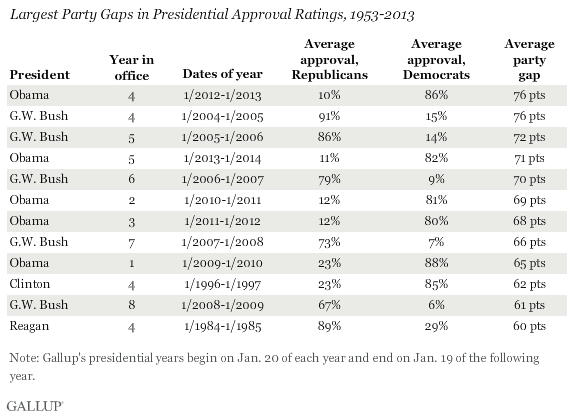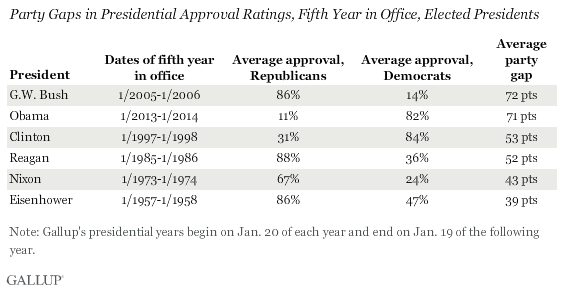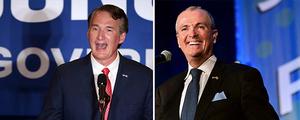PRINCETON, NJ -- The partisan gap in President Barack Obama's job approval rating was 71 percentage points during his fifth year in office, with 82% of Democrats and 11% of Republicans approving, on average. That is down from a 76-point gap during his re-election year, but continues to reflect the high degree of political polarization in presidential job ratings during his time in office.

The results are based on more than 175,000 Gallup Daily tracking interviews conducted throughout Obama's fifth year in office, from Jan. 20, 2013, through Jan. 19, 2014.
Obama's fifth year in office ranks as the fourth-most polarized presidential year in Gallup's records, which date back to the Eisenhower presidency. In fact, all five of Obama's years in office rank among the 10-most polarized, with his fourth year edging out George W. Bush's fourth year in office for the top overall spot. Four of Bush's years in office rank among the 10-most politically polarized in terms of presidential job approval.

This recent era of extreme party polarization in views of the president began in Bush's fourth year in office, and has continued uninterrupted. Each year since 2004, the average party gap in presidential job approval has been 60 percentage points or greater. The only other two years with that degree of polarization were Ronald Reagan's and Bill Clinton's re-election years.
Obama's Fifth Year Slightly Less Polarized Than Bush's Fifth Year
Obama's first, second, third, and fourth years in office were the most polarized for any president's first, second, third, or fourth years. However, the 71-point party gap in ratings of Obama's job approval during his fifth year in office is slightly less than the 72-point gap found in Bush's fifth year. After Obama, the next largest fifth-year gap was 53 points for Clinton.

Apart from Nixon, whose fifth year was marred by the Watergate scandal, most presidents got similarly high ratings from their party's supporters in their fifth year, ranging from 82% for Obama to 88% for Reagan. The differences in polarization are attributable to the ratings presidents received from supporters of the opposition party. Bush and Obama had approval ratings of 14% and 11% from Democrats and Republicans during their fifth year in office, respectively. Reagan, Clinton, and Eisenhower received approval ratings of at least 30% from the opposition party during the fifth year of their administrations.
Implications
Obama is on course to have the most politically polarized approval ratings of any president, with an average 69-point gap during his presidency, a full eight points higher than was the case with Bush. There have always been party differences in presidential ratings, but these have become more extreme in recent decades, averaging 34 points before Reagan's presidency and 58 points after. This is due more to presidents receiving comparatively lower approval ratings from the opposition party than it is from extremely high support from their own party, though both are factors.
Obama's highly polarized ratings, then, may have as much to do with the era in which he is governing as they do with his actions as president. Both Obama and Bush made overtures toward bringing politically divided Americans together, but the evidence suggests neither succeeded. That said, it is not clear that presidents will be very successful in gaining significant support from the opposition party, regardless of what they do in the current political environment.
Explore President Obama's approval ratings in-depth and compare them with those of past presidents in the Gallup Presidential Job Approval Center.
